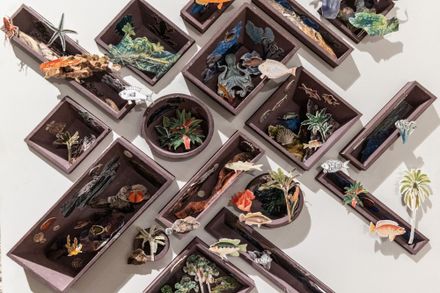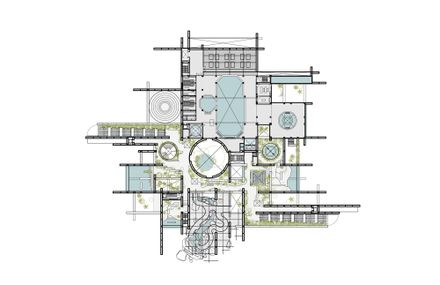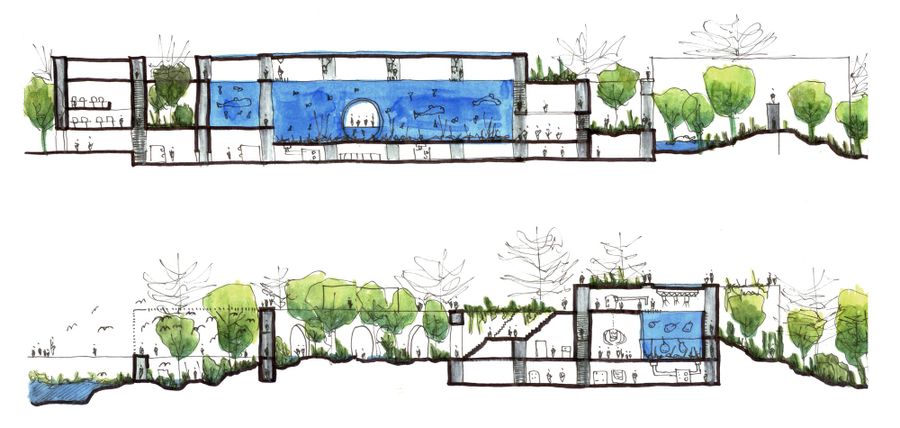
Cortés Sea Research Center Tatiana Bilbao
CORTÉS SEA RESEARCH CENTER TATIANA BILBAO

ARCHITECTS
tatiana bilbao
LEAD ARCHITECT
tatiana bilbao
PROJECT CHIEF
alba cortés
ASSOCIATE ARCHITECTS
catia bilbao, juan pablo benlliure, alba cortés, mariano castillo, soledad rodríguez
PROJECT DIRECTOR
udayan mazumdar, alba cortés
CONSTRUCTION DIRECTOR
Soledad Rodríguez
DESIGN TEAM
Sofía Betancourt, Simona Solórzano, Gonzalo Mauleón, Mónica Lamela, Pavel Manzano, Steven Beltrán, Vania Aldonza Torres, Christian Belmont, Francisco Lozano, Octavio Herrejón, Pedro Gaxiola, Emma Woodward, Vittoria Di Giunta, Andrea Celso, Daniela Oria, Renata de Miguel, Fernanda Tovar, Patricio Tejedo, Mariana Martins, Elsa Ponce, María Escudero, Miriam Hernández, Kerstin Röck, Helene Schauer, Brice Franquesa, Hyeree Kwak, Morgan Tyson, Ayesha S. Ghosh, Carlos Baeza
PHOTOGRAPHYS
Juan Manuel McGrath
AREA
13000 M²
YEAR
2023
LOCATION
MAZATLÁN, MEXICO
CATEGORY
Aquarium

English description provided by architect.
The project is part of the regeneration program for the Mazatlan Central Park. The intention is to complement the public, natural, and cultural area of great social interest, marked by the quality and uniqueness of the overall intervention.
The project will offer a complete experience of the marine ecosystems of the Sea of Cortez, as well as the terrestrial ecosystems of its shores.


The proposed building is the place where nature, both marine and terrestrial, meets architecture and the world of human beings.
Nature lives and grows around and inside the building, giving the project identity, a sense of belonging to the place, and making the experience unique and complete.
As a trigger for the space, an orthogonal, rational, functional, and flexible structure is proposed, with identity and belonging to the place where it is implanted.


It simultaneously solves spaces, structures, envelopes, installations, and integration with the environment.
Programmatic, functional, and service walls and installations extend irregularly into the surroundings, integrating with the surrounding landscape and providing structural stability to the building.
The project seeks to increase the surface area of contact between the interior and exterior, blurring the boundaries between them and allowing for greater interaction.
The intention of the project is to immerse the visitor in the natural world through the journey of the extended exterior public space from the surroundings to the top of the building, and then descend to the central public access plaza from where visitors will begin their exhibition journey.


From this plaza, visitors can access each of the exhibition ecosystems, open sea, coasts, land, and forest, as well as educational programs such as an auditorium and public laboratory. The exhibition experience can begin with any of the ecosystems.
The visitor can follow the exhibition continuously and flexibly, as the sequence of spaces communicates the programs continuously and at the same time transversely and in continuous contact with the exterior natural environment.


The project is developed on three levels. The first, is at the ground floor level, where the administrative and staff areas, reception of school groups, part of the public services, and a large part of the marine life conservation and support facilities, as well as centralized general facilities, are located.
On the next level, the first floor, the general access plaza, exhibition, and public services are located. Above the previous level, in only one sector of the floor, is the area of support and attention to the large tanks of the exhibition, with complementary programs of changing rooms, toilets, and equipment for the maintenance personnel of the tanks and visitors for immersion in the oceanic tank.


On this floor are the remaining facilities and equipment for marine life support.


















